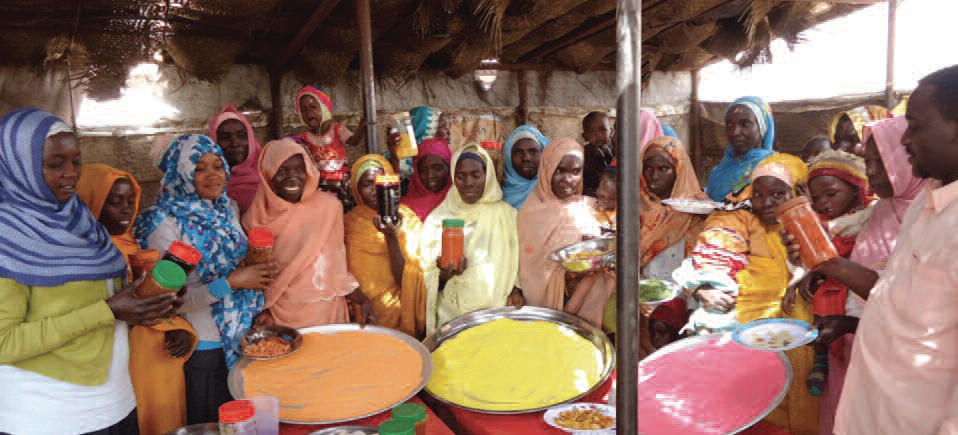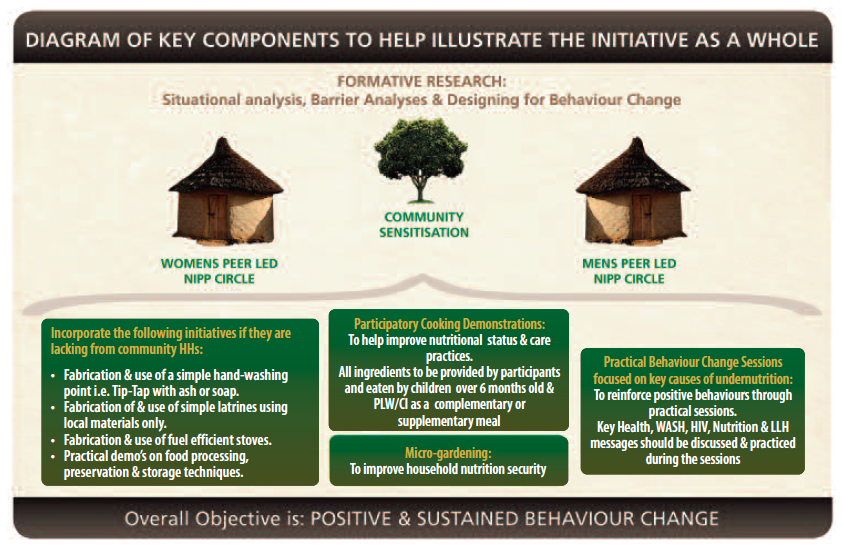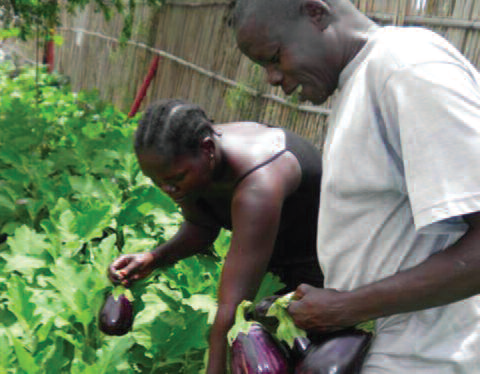Nutrition Impact and Positive Practice Circles
 Vimbai Chishanu et al., GOAL
Vimbai Chishanu et al., GOAL
Field Exchange 47, p43
The Nutrition Impact and Positive Practice (NIPP) circle methodology is a community nutrition approach that aims to address problems of undernutrition sustainably by supporting communities to help themselves, using locally available resources and low-cost technologies. NIPP circles are used in community contexts where a lack of dietary diversity and inappropriate social, care, health or environmental health practices have been identified as contributory factors in causing undernutrition.
How NIPP circles work
NIPP circles are separate gatherings of males and females within a community to allow for men and women to freely express themselves and to focus on gender specific barriers and motivators for change. The circles aim to facilitate knowledge and skills sharing of both men and women using group discussions, practical exercises and positive reinforcement to help families adopt sustainable, positive behaviours. There are three main areas of focus: (a) Behaviour Change Communication and Counselling,for improved awareness and practice (b) Micro-gardening,for improved nutrition security and (c) Cooking demonstrations, for improved feeding and care practices. This allows the project to address some of the underlying causes of undernutrition.
Figure 1: Diagram of key components of the NIPP circles approach

Over a period of up to 12 weeks, the members meet on a regular basis for two to three hours at a time, to discuss and learn about recommended practices and access peer support. NIPP circles are led by trained community volunteers (male and female) who are positive role models in the community and whose households have a comparatively better nutritional status than the others.
There are a number of high-risk individuals who are prioritized or the NIPP circles1 including:
- children discharged from outpatient treatment for severe acute malnutrition (SAM)
- children with moderate acute malnutrition (MAM) • malnourished/at risk infants < 6 months of age
- malnourished pregnant or lactating women, and
- families with chronic illness.
Malnourished children may be admitted based on low Mid- Upper Arm Circumference (MUAC), weight-for-height or weight-for-age criteria, to encourage inclusivity (e.g. referral from growth monitoring clinics).
The Ministries of Health and Agriculture, in addition to the GOAL staff in-country, provide technical trainings to staff and volunteers, including MUAC screening, counselling and behaviour change techniques, construction and use of micro-gardens, construction and use of fuel efficient stoves, participatory cooking demonstrations, food preservation, processing and storage, tippy-taps2 (or alternative) and latrine construction. They also assist with monitoring and support to households to implement behaviour change and assist with data collection where workload permits.
Health centres are linked directly with the NIPP circles, with participants referred to health facilities for available services (treatment of illnesses, ante-natal and postnatal care, expanded programme on immunisation, and growth monitoring where appropriate etc). Outpatient therapeutic programme discharges are also referred to NIPP circles after treatment.
Programme rollout
In collaboration with governments and local community based national NGOs, GOAL is rolling out the NIPP circles in South Sudan, Sudan and Zimbabwe. To date 50, 125 and 25 NIPP macro circles have been rolled out respectively.
Programme monitoring
A realistic, simple monitoring system has been designed to enable GOAL to monitor various outcomes, including anthropometric status of young children and pregnant and lactating women, care and feeding practices, microgardening, food use, hygiene-sanitation practices and HIV prevention awareness. Data are collected at baseline, upon graduation for all admissions, then two months, six months and 12 months post-graduation, which will help to provide a picture of the sustainability of different elements of the project.
Project costs
Based on costings from the Zimbabwe programme, a conservative calculation of the cost per beneficiary (the core direct beneficiaries) is ~£67/person per annum.
 Outcomes and learning
Outcomes and learning
There have been many positive outcomes from the multicountry NIPP circle project, such as:
- In one location in South Sudan, the circle members set up their own small village savings and loans scheme independently of GOAL. The savings were used to buy subsequent cycles of seeds where harvesting proved difficult.
- In another site in South Sudan, one of the male circles requested that they be tasked with the practical construction and maintenance of the micro-gardens instead of their wives, as part of role-sharing between themselves and their spouses.
- The significant role grandmother’s play in family nutrition has been re-affirmed in initial contexts and they are now explicitly invited to join the female circles, particularly when IYCF practices are being discussed.
Programme challenges
The main challenges include:
- Poor male participation in the circle activities, although this is being addressed in different ways in different sites, depending on the barriers identified.
- Volunteer participation (in South Sudan) as GOAL does not provide incentives to participate in the programme, which has required repeat community discussions and buy-in, motivating communities to want to help themselves.
- Shortage of water in dry areas. Maximising yields during rain fed seasons is promoted with subsequent processing, preservation and storage being used to improve access to harvested produce during the lean seasons. Additionally the use of household wastewater to water reduced sized micro-gardens during dry spells is promoted.
GOAL has also experienced problems in a number of field sites, whereby poor coordination between partner NGOs has resulted in the promotion of non-NIPP projects using different forms of volunteer incentivisation (either financial, food or non-food items), leading to difficulties in compliance for the NIPP project that works through volunteerism.
Conclusions
For all implementing GOAL support teams, it has been particularly interesting to facilitate a project that seeks to address undernutrition through an integrated and multisectoral community-based approach, using close coordination between sectors. Additionally, the positive feedback and uptake so far suggest there is great potential for local partners, national NGOs and the Ministry of Health to run the project longer term at minimal cost.
1For details on admission and discharge criteria see original article in FEX 47 www.ennonline.net/fieldexchange
2Tippy-taps are an easily constructed, small-scale hand washing points for households, using locally available and accessible materials.
3A macro circles is comprised of a female circle a parallel male circle and the community circle

